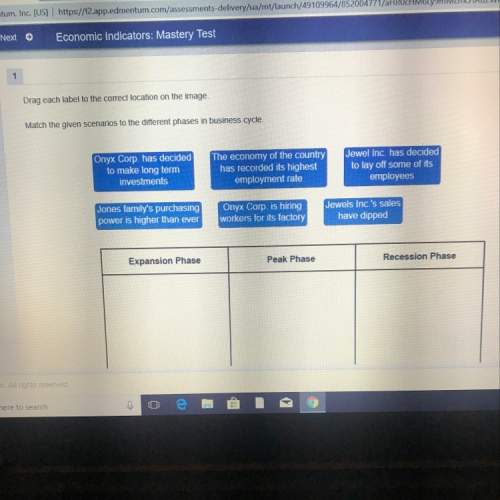
Suppose you bought a bond with an annual coupon rate of 4.2 percent one year ago for $900. The bond sells for $950 today. a. Assuming a $1,000 face value, what was your total dollar return on this investment over the past year? b. What was your total nominal rate of return on this investment over the past year? (Do not round intermediate calculations and enter your answer as a percent rounded to 2 decimal places, e. g., 32.16.) c. If the inflation rate last year was 2.5 percent, what was your total real rate of return on this investment? (Do not round intermediate calculations. Enter your answer as a percent rounded to 2 decimal places, e. g., 32.16.)

Answers: 3
Another question on Business

Business, 21.06.2019 20:30
Which of the following best describes how the federal reserve bank banks during a bank run? a. the federal reserve bank regulates exchanges to prevent the demand for withdrawals from rising above the required reserve ratio. b. the federal reserve bank acts as an insurance company that pays customers if their bank fails. c. the federal reserve bank has the power to take over a private bank if customers demand too many withdrawals. d. the federal reserve bank can provide a short-term loan to banks to prevent them from running out of money. 2b2t
Answers: 2

Business, 22.06.2019 04:00
Assume that the following conditions exist: a. all banks are fully loaned up- there are no excess reserves, and desired excess reserves are always zero. b. the money multiplier is 5 . c. the planned investment schedule is such that at a 4 percent rate of interest, investment =$1450 billion. at 5 percent, investment is $1420 billion. d. the investment multiplier is 3 . e.. the initial equilibrium level of real gdp is $12 trillion. f. the equilibrium rate of interest is 4 percent now the fed engages in contractionary monetary policy. it sells $1 billion worth of bonds, which reduces the money supply, which in turn raises the market rate of interest by 1 percentage point. calculate the decrease in money supply after fed's sale of bonds: $nothing billion.
Answers: 2

Business, 22.06.2019 18:50
Plastic and steel are substitutes in the production of body panels for certain automobiles. if the price of plastic increases, with other things remaining the same, we would expect: a) the demand curve for plastic to shift to the left. b) the price of steel to fall. c) the demand curve for steel to shift to the left d) nothing to happen to steel because it is only a substitute for plastic. e) the demand curve for steel to shift to the right
Answers: 3

Business, 22.06.2019 20:50
The following accounts are from last year’s books at s manufacturing: raw materials bal 0 (b) 157,400 (a) 172,500 15,100 work in process bal 0 (f) 523,600 (b) 133,700 (c) 171,400 (e) 218,500 0 finished goods bal 0 (g) 477,000 (f) 523,600 46,600 manufacturing overhead (b) 23,700 (e) 218,500 (c) 27,700 (d) 159,400 7,700 cost of goods sold (g) 477,000 s manufacturing uses job-order costing and applies manufacturing overhead to jobs based on direct labor costs. what is the amount of cost of goods manufactured for the year
Answers: 3
You know the right answer?
Suppose you bought a bond with an annual coupon rate of 4.2 percent one year ago for $900. The bond...
Questions


Mathematics, 09.03.2020 05:36



Biology, 09.03.2020 05:37

English, 09.03.2020 05:37

Mathematics, 09.03.2020 05:37

English, 09.03.2020 05:37

Mathematics, 09.03.2020 05:37

Chemistry, 09.03.2020 05:37





History, 09.03.2020 05:38



English, 09.03.2020 05:39

Biology, 09.03.2020 05:39

Mathematics, 09.03.2020 05:39




